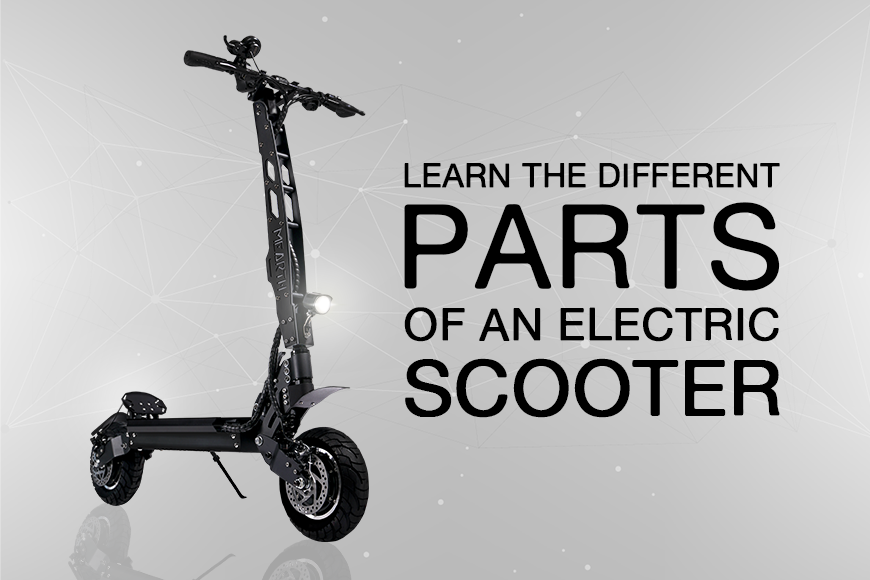
Although there are different types of electric scooters, an electric scooter consists of standard parts that allow it to function as an efficient and fast mode of transportation. If you own an electric scooter, knowing each part of the vehicle will allow you to care for it better, check on important parts for maintenance, know how it functions and how to describe a malfunction to a mechanic in case of repairs.
To learn more about an e-scooter, this electric scooter guide will give a quick rundown on the different parts of an electric scooter using the Mearth GTS.
Let’s start from the top!
1. Handlebar

The handlebar is the part that you interact with the most. On this part, you can see the handles, display screen, brake controls, accelerator, and other features and controls of your electric scooter. Depending on your electric scooter, the display screen usually shows your current speed, battery level, speed mode, and more.
In some portable models, the handlebars can be folded to reduce the width of a folded e-scooter. This makes it easier to carry or store the electric scooter.
Overall, your e-scooter handles are an important part of controlling your e-scooter. A good handlebar consists of handles with a good grip and controls that are designed for ease of use.
2. Stem

The stem is the long tube that connects your handlebar to the front wheel and the rest of the electric scooter parts. This part can be folded and can become a handle when the e-scooter is carried.
Unfortunately, most foldable electric scooters tend to have wobbly stems due to their design. To prevent any damage to the folding mechanism and the stem, avoid putting pressure on the handlebars.
3. Lights

Most electric scooters have a built-in LED headlight and a tail light which gives enough illumination to see and stay visible during night rides. Some electric scooters also include multi-coloured LED lights at the side or bottom of the deck, adding more visibility for the rider. When checking the lights of an e-scooter, make sure it gives enough illumination to help you see the road, especially at night.
4. Battery

The battery is the gas tank of an e-scooter, and it’s made up of many cells that store the energy that your electric scooter needs to ride. Batteries are usually located under the deck, but in some cases, they can be found within the stem. Most electric scooters also use Lithium-ion batteries because they have better capacity and stability.
The battery is also one of the most important factors when it comes to range. The higher the battery capacity, the longer the range. So, if you want to ride long ranges, make sure that your battery has enough capacity. If you want to know how to get the most from your batteries, here’s a quick guide on how to get more mileage from your electric scooter battery.
5. Deck

The platform where you stand is called the deck. Different electric scooters use different materials for the deck, but most models use rubberised decks for better grip. Some models also adorn the deck with LED lights to add more style and visibility to the e-scooter.
E-scooter decks usually measure 14” x 5”, which is just wide enough to place your feet. If you prefer more stability and comfort, try to look for an e-scooter with a wider deck.
6. Controllers

Image via Amazon
A speed controller is a component located within the e-scooter that looks like a rectangular metal with many different wires attached to it. The controller manages the current flow from the battery to the motor. The controller bases how much current flow passes through via the accelerator.
Controllers are the lesser-known and underappreciated part of the electric scooter, since they are just quietly running within the e-scooter. However, if something goes wrong with the controller, it can be difficult to repair and can make the e-scooter dangerous.
7. Tyres

There are two types of tyres: pneumatic (air-filled) and solid (airless). Pneumatic tyres, like the Mearth GTS above, provide better ride quality as it cushions bumps better than solid tyres. However, the downside to pneumatic tyres is that they are vulnerable to punctures.
On the other hand, solid tyres offer less maintenance and promise no punctures at all. However, since there’s nothing to cushion bumps on the road, solid tyres offer poor ride quality. Both e-scooter tyres have their pros and cons. Choose the one that meets your riding style.
If you’re not sure what type of tyres to look for, here’s a quick guide to help you out.
8. Motor

The electric scooter motor is usually placed within one or both of the e-scooter wheels. These are brushless direct current electric motors (BLDC) built within wheel hubs. Powerful e-scooters, like those used for off-roading, have dual motors, which means there’s one in each wheel.
E-scooter motors are measured in wattage and rated based on power consumption. The higher the wattage, the more powerful the electric motor. Commuter e-scooters usually have around 250W to 500W motors, while off-road e-scooters offer 1200W motors and above.
9. Brakes

The brakes are an important part of an e-scooter since it helps you stay safe and in control while riding. There are different types of breaks, but, essentially, they can be divided into mechanical brakes and electronic brakes.
Mechanical brakes use mechanisms to slow down. The different types of mechanical brakes include disc, drum, and foot brakes. On the other hand, electronic brakes use the motor to stop, and it includes electronic and regenerative brakes.
Mechanical brakes offer stronger braking power, but electronic brakes don’t need any maintenance at all. If you want to learn more about brakes, here’s a beginner’s guide to electric scooter brakes.
10. Suspension

Finally, the last e-scooter part is the suspension. The suspension helps improve ride quality as it stabilises the ride on bumpy roads. The types of suspension that are commonly found on e-scooters include hydraulic, spring, and rubber suspension.
However, only a few electric scooters have suspension. Most e-scooter models prefer to use pneumatic tyres to cushion the ride when going through rough terrains. After all, larger pneumatic tyres can offer better shock absorption than suspensions.
Hopefully, this quick guide of the different parts of the electric scooter has helped you understand how it works and learn more about each part. Take note of all these parts so that you will know what to check when looking for an electric scooter and how to care for it.




Leave a comment
This site is protected by hCaptcha and the hCaptcha Privacy Policy and Terms of Service apply.